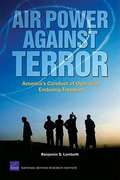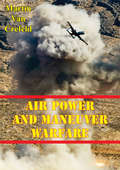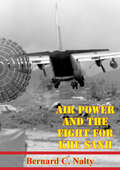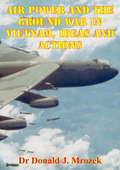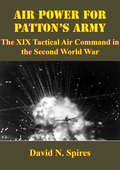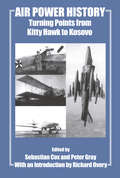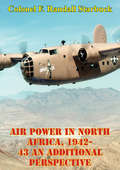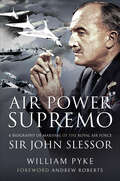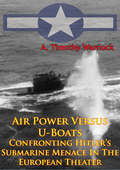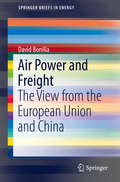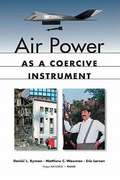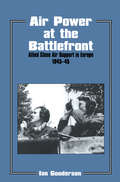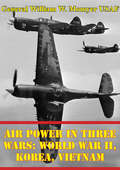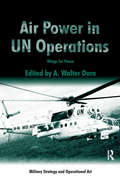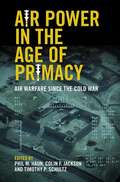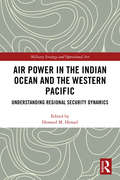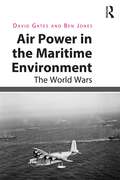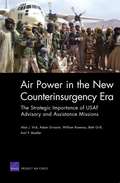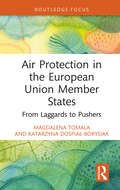- Table View
- List View
Air Power Against Terror: America's Conduct of Operation Enduring Freedom
by Benjamin S. LambethThe terrorist attacks of 9/11 plunged the United States into a determined counteroffensive against Osama bin Laden and his al Qaeda terrorist network. This report details the initial U.S. military response to those attacks, namely, the destruction of al Qaeda?'s terrorist infrastructure and the removal of the ruling Taliban regime in Afghanistan. The author emphasizes several distinctive achievements in this war, including the use of precision air-delivered weapons that were effective irrespective of weather, the first combat use of Predator unmanned aerial vehicles armed with Hellfire missiles, and the integrated employment of high-altitude drones and other air- and space-based sensors that gave CENTCOM unprecedented round-the-clock awareness of enemy activity.
Air Power And Maneuver Warfare
by Professor Martin Van CrefeldAn essential part of the Air War College, Maxwell Air Force Base (AFB), Alabama, curriculum consists of the study of military history and specific campaigns. Distinguished military scholars often visit the college to discuss and explore issues with the faculty. Martin van Creveld was one of those distinguished scholars. He had previously been commissioned by the Air Staff to investigate the effects of the US Army's move toward a more maneuver-oriented kind of warfare and the effect that move will have on the US Air Force role on the battlefield. The Air Staff was concerned about a host of issues: logistic support for a highly mobile force; friendly force confusion on huge, rapidly changing battlefields; close air support with or without air base support; and a host of other issues. The bottom line for the Air Force concerned several issues of great impact. First, Must air combat change because land combat is changing? and, Is the decisiveness of air power increasing geometrically to the point where the twenty-first century will find it is as decisive as ground power was in the twentieth century?Our guest historian agrees that sophisticated, highly technical air and space developments may have made air power dominant on the conventional battlefield. The great exception, however, lies in the trend away from conventional to unconventional conflict. To Professor van Creveld, nation-states have lost the monopoly on the legitimate use of violence. To prepare for a conventional scenario is to prepare for the last war, not the next one. The possibility of more "Lebanons" is much higher than the likelihood of future "Iraqs."
Air Power And The Fight For Khe Sanh [Illustrated Edition]
by Bernard C. NaltyIncludes 60 photos and 7 maps and chartsThe 1968 fight for Khe Sanh pitted some 6,000 U.S. Marines and South Vietnamese Rangers against an enemy force roughly three times as large. For more than 70 days North Vietnamese troops maintained pressure on Khe Sanh's defenders, who had dug in around the base's airstrip. The original purpose for deploying the Marines and South Vietnamese into the northwest corner of South Vietnam was to block Communist troop movements along Highway 9 toward Quang Tri City and the heavily populated coastal areas. When U.S. intelligence detected large enemy forces assembling near Khe Sanh, the senior American commander in Vietnam, Gen. William C. Westmoreland, ordered the Marines to hold the base.During the siege that followed, U.S. strike aircraft rained nearly 100,000 tons of munitions down upon the North Vietnamese while other planes--primarily U.S. Air Force transports--flew in essential supplies of food, ammunition, and other necessities to Khe Sanh's defenders. The Leathernecks also used their own aircraft to provision Marine outposts which denied the enemy the high ground overlooking the base. Other military elements participating in the battle included U.S. Army artillerymen dug in east of Khe Sanh, who fired deadly concentrations against the besieging forces. Marine howitzers and mortars added to the heavy U.S. fire, while Army engineers joined Navy Seabees in helping prepare airstrips which supported the allied defense effort. Finally, the relief of Khe Sanh--though spearheaded by Army troops--also involved American Marines and soldiers of the Army of the Republic of Vietnam.
Air Power And The Ground War In Vietnam, Ideas And Actions: Ideas And Actions
by Dr Donald J. MrozekUltimately, this study is about a smaller Vietnam War than that which is commonly recalled. It focuses on expectations concerning the impact of air power on the ground war and on some of its actual effects, but it avoids major treatment of some of the most dramatic air actions of the war, such as the bombing of Hanoi. To many who fought the war and believe it ought to have been conducted on a still larger scale or with fewer restraints, this study may seem almost perverse, emphasizing as it does the utility of air power in conducting the conflict as a ground war and without total exploitation of our most awe-inspiring technology.Although the chapters in this study are intended to form a coherent and unified argument, each also offers discrete messages. The chapters are not meant to be definitive. They do not exhaust available documentary material, and they often rely heavily on published accounts. Nor do they provide a complete chronological picture of the uses of air power, even with respect to the ground war. Nor is coverage of areas in which air power was employed--South Vietnam, Laos, Cambodia, and North Vietnam--evenly distributed nor necessarily proportionate to the effort expended in each place during the war. Lastly, some may find one or another form of air power either slightly or insufficiently treated. Such criticisms are beside the point, for the objectives of this study are to explore a comparatively neglected theme--the impact of air power on the ground--and to encourage further utilization of lessons drawn from the Vietnam experience.
Air Power For Patton’s Army: The XIX Tactical Air Command In The Second World War [Illustrated Edition]
by David N. SpiresIllustrated with 3 charts, 28 maps and 88 photos.This insightful work by David N. Spires holds many lessons in tactical air-ground operations. Despite peacetime rivalries in the drafting of service doctrine, in World War II the immense pressures of wartime drove army and air commanders to cooperate in the effective prosecution of battlefield operations. In northwest Europe during the war, the combination of the U.S. Third Army commanded by Lt. Gen. George S. Patton and the XIX Tactical Air Command led by Brig. Gen. Otto P. Weyland proved to be the most effective allied air-ground team of World War II.The great success of Patton's drive across France, ultimately crossing the Rhine, and then racing across southern Germany, owed a great deal to Weyland's airmen of the XIX Tactical Air Command. This deft cooperation paved the way for allied victory in Western Europe and today remains a classic example of air-ground effectiveness. It forever highlighted the importance of air-ground commanders working closely together on the battlefield.
Air Power History: Turning Points from Kitty Hawk to Kosovo (Studies in Air Power #Vol. 13)
by Peter Gray Richard Overy Sebastian Coxhe 20th century saw air power transformed from novelists' fantasy into stark reality. From string and canvas to precision weaponry and stealth, air power has progressed to become not only the weapon of first political choice, but often the only conceivable option. This rapid development has given rise to considerable debate and controversy with those holding entrenched views rarely slow to shout their case. Many myths have grown over the period, ranging from the once much vaunted ability of air power to win wars alone through to its impact as a coercive tool.This volume examines the theory and practice of air power from its earliest inception. The contributors have been drawn from academia and the military and represent some of the world's leading proponents on the subject. All significant eras on air power employment are examined: some are evidently turning points, while others represent continuous development. Perhaps more importantly, the book highlights the areas that could be considered to be significant, and invites the reader to enter the debate as to whether it constitutes a continuum, a turning point, or indeed a revolution.
Air Power In North Africa, 1942-43: An Additional Perspective
by Colonel F. Randall StarbuckThe hastily mounted invasion of French Northwest Africa in November of 1942 was a gamble. It exposed American inexperience. That inexperience went from Roosevelt on down to the soldier in the foxhole. Half-trained men were pitted against Vichy France and didn't know whether to expect open arms or open fire. Later, those same inexperienced men would meet Rommel at the Kasserine Pass. This naivete was exhibited by both men and leaders. Torch was Eisenhower's first major operation--a gigantic airlift and sealift preceded by months of intrigue. The outcome of the campaign settled several air power issues and revealed many lessons. The battles fought by the United States forces during the North African Campaign of 1942 and 1943, particularly the Battle for the Kasserine Pass in February 1943, were a breaking and testing ground for much of the employment of those forces during the remainder of the Second World War. Three air power key lessons were learned on the North African battlefield. First was the need for coordination between air and ground forces. Second was the folly of sending untrained airmen into combat. Third was the importance of tactical air targeting by ground force commanders.
Air Power Supremo: A Biography of Marshal of the Royal Air Force Sir John Slessor
by William PykeSir John Slessor was one of the twentieth century’s most distinguished wartime commanders and incisive military thinkers, and William Pyke’s comprehensive new biography reveals how he earned this remarkable reputation. Slessor, a polio victim who always walked with a stick, became a First World War pilot in the Sudan and on the Western Front and a squadron and wing commander in India between the wars. When aerial warfare was still a new concept, he was one of the first to develop practical tactics and strategies in its application. In the Second World War, as the Commander-in-Chief of Coastal Command during the Battle of the Atlantic and the RAF in the Mediterranean during the Italian and Balkan campaigns, he made a remarkable contribution to the success of Allied air power. Then, after the war, as a senior commander he established himself as one of the foremost experts on strategic bombing and nuclear deterrence. That is why this insightful biography of a great British airman and his achievements is so timely and important as we enter a new era of strategic doubts and deterrence at the beginning of the twenty-first century. William Pyke follows each stage of Slessor’s brilliant career as a pilot and commander in vivid detail. In particular he concentrates on Slessor’s writings, from his treatise on the application of air power in support of land armies to his thinking on nuclear deterrence and Western strategy.
Air Power Versus U-Boats - Confronting Hitler’s Submarine Menace In The European Theater [Illustrated Edition]
by A. Timothy WarnockIncludes over 14 photos and mapsMore than fifty years after World War II, America's major air power contribution to the war in Europe-in efforts such as Big Week, Regensburg, and Patton's dash across Europe-live on in the memories of airmen and students of air power. Never before had air forces performed so many roles in so many different types of operations. Air power proved to be extremely flexible: wartime missions included maintaining air superiority, controlling the air space over the battlefield; strategic bombardment, destroying the enemy's industrial and logistical network; air-ground support, attacking targets on the battlefield; and military airlift, delivering war materiel to distant bases.Perhaps one of the least known but significant roles of the Army Air Forces (AAF) was in antisubmarine warfare, particularly in the European-African-Middle Eastern theater. From the coasts of Greenland, Europe, and Africa to the mid-Atlantic, AAF aircraft hunted German U-boats that sank thousands of British and American transport ships early in the war. These missions supplemented the efforts of the Royal Navy, the Royal Air Force Coastal Command, and the U.S. Navy, and helped those sea forces to wrest control of the sea lanes from German submarines.
Air Power and Freight: The View from the European Union and China (SpringerBriefs in Energy)
by David BonillaThis book addresses the challenges of planning sustainable freight transport systems (road and air) in a time when the industry faces increasing pressure from environmental limits, climate change, carbon emission targets, bottlenecks in oil supply, infrastructure shortages and urban congestion. The author examines sustainable freight transport over the last 45 years on three continents, and includes developments on transport economics, logistics and transport geography as well as environmental economics. Readers will gain valuable insight on a number of practices and methodologies that will assist in making their systems more sustainable with fewer negative environmental effects at both the local and global level.
Air Power as a Coercive Instrument
by Ian O. Lesser Keith Crane Seth G. Jones Rollie Lal John G. Mcginn Daniel BymanCoercion--the use of threatened force to induce an adversary to change its behavior--is a critical function of the U.S. military. U.S. forces have recently fought in the Balkans, the Persian Gulf, and the Horn of Africa to compel recalcitrant regimes and warlords to stop repression, abandon weapons programs, permit humanitarian relief, and otherwise modify their actions. Yet despite its overwhelming military might, the United States often fails to coerce successfully. This report examines the phenomenon of coercion and how air power can contribute to its success. Three factors increase the likelihood of successful coercion: (1) the coercer's ability to raise the costs it imposes while denying the adversary the chance to respond (escalation dominance); (2) an ability to block an adversary's military strategy for victory; and (3) an ability to magnify third-party threats, such as internal instability or the danger posed by another enemy. Domestic political concerns (such as casualty sensitivity) and coalition dynamics often constrain coercive operations and impair the achievement of these conditions. Air power can deliver potent and credible threats that foster the above factors while neutralizing adversary counter-coercive moves. When the favorable factors are absent, however, air power--or any other military instrument--will probably fail to coerce. Policymakers' use of coercive air power under inauspicious conditions diminishes the chances of using it elsewhere when the prospects of success would be greater.
Air Power at the Battlefront: Allied Close Air Support in Europe 1943-45 (Studies in Air Power #Vol. 6)
by Dr Ian GoodersonIan Gooderson presents a study of close air support in World War II, with the analysis focusing on the use of tactical air power by British and American forces during the campaigns in Italy and northwestern Europe between 1943 and 1945.
Air Power in Three Wars: World War II, Korea, Vietnam [Illustrated Edition]
by General William W. Momyer USAF[Includes over 130 illustrations and maps]This insightful work documents the thoughts and perspectives of a general with 35 years of history with the U.S. Air Force - General William W. Momyer. The manuscript discusses his years as a senior commander of the Air Force - strategy, command and control counter air operations, interdiction, and close air support. His perspectives cover World War II, the Korean War and the Vietnam War.
Air Power in UN Operations: Wings for Peace (Military Strategy and Operational Art)
by A. Walter DornAir power for warfighting is a story that's been told many times. Air power for peacekeeping and UN enforcement is a story that desperately needs to be told. For the first-time, this volume covers the fascinating range of aerial peace functions. In rich detail it describes: aircraft transporting vital supplies to UN peacekeepers and massive amounts of humanitarian aid to war-affected populations; aircraft serving as the 'eyes in sky' to keep watch for the world organization; and combat aircraft enforcing the peace. Rich poignant case studies illuminate the past and present use of UN air power, pointing the way for the future. This book impressively fills the large gap in the current literature on peace operations, on the United Nations and on air power generally.
Air Power in the Age of Primacy: Air Warfare since the Cold War
by Timothy P. Schultz Phil M. Haun Colin F. JacksonSince the end of the Cold War the United States and other major powers have wielded their air forces against much weaker state and non-state actors. In this age of primacy, air wars have been contests between unequals and characterized by asymmetries of power, interest, and technology. This volume examines ten contemporary wars where air power played a major and at times decisive role. Its chapters explore the evolving use of unmanned aircraft against global terrorist organizations as well as more conventional air conflicts in Bosnia, Kosovo, Afghanistan, Iraq, Lebanon, Libya, Yemen, Syria, and against ISIS. Air superiority could be assumed in this unique and brief period where the international system was largely absent great power competition. However, the reliable and unchallenged employment of a spectrum of manned and unmanned technologies permitted in the age of primacy may not prove effective in future conflicts.
Air Power in the Age of Total War (Warfare and History)
by John BuckleyWarfare in the first half of the 20th century was fundamentally and irrovocably altered by the birth and subsequent development of air power. This work assesses the role of air power in changing the face of battle on land and sea. Utilizing late-1990s research, the author demonstrates that the phenomenon of air power was both a cause and a crucial accelerating factor contributing to the theory and practice of total war. For instance, the expansion of warfare to the homefront was a direct result of bombing and indirectly due to the extent of national economic mobilization required to support first rate air power status. In addition, the move away from the principle of total war with the onset of the Cold War and the replacement of air power by ICBMs is thoroughly examined. This work should provide students of international history, war studies, defence and strategic studies with an insight into 20th-century warfare.
Air Power in the Falklands Conflict: An Operational Level Insight into Air Warfare in the South Atlantic
by John ShieldsFrom the television footage shown in all its stark reality and the daily coverage and subsequent memoirs, the impression delivered from the air battles in the Falklands Conflict was that of heroic Argentine pilots who relentlessly pressed home their attacks against the British. While, by contrast, there is a counter-narrative that portrayed the Sea Harrier force as being utterly dominant over its Argentine enemies. But what was the reality of the air war over the Falkland Islands? While books on the air operations have published since that time, they have, in the main, been personal accounts, re-told by those who were there, fighting at a tactical level, or back in their nation’s capital running the strategic implications of the outcome. But a detailed analysis of the operational level of the air war has not been undertaken – until now. At the same time, some analysts have inferred that this Cold War sideshow offers little insight into lessons for the operating environment of future conflicts. As the author demonstrates in this book, there are lessons from 1982 that do have important and continued relevance today. Using recently released primary source material, the author, a serving RAF officer who spent two-and-a-half years in the Falklands as an air defence navigator, has taken an impartial look at the air campaign at the operational level. This has enabled him to develop a considered view of what should have occurred, comparing it with what actually happened. In so doing, John Shields has produced a comprehensive account of the air campaign that has demolished many of the enduring myths. This is the story of not why, but how the air war was fought over the skies of the South Atlantic.
Air Power in the Indian Ocean and the Western Pacific: Understanding Regional Security Dynamics (Military Strategy and Operational Art)
by Howard M. HenselThis book examines the security dynamics of the Indian Ocean and the Western Pacific, concentrating upon an analysis and evaluation of the air power capabilities of the various powers active in the two regions. The volume is designed to help improve understanding of the heritage and contemporary challenges confronting the global community in the Indian Ocean and the Western Pacific, as well as to illuminate the policies of the various powers involved in the affairs of these regions, and the military capabilities that are available in support of those policies. The 16 individual chapters examine both the traditional and the non-traditional threats that confront the various Indian Ocean and Western Pacific powers, and assess the roles played by land-based and naval, fixed-wing and rotary-wing, manned and unmanned aircraft, as well as by offensively and defensively capable ballistic and cruise missiles in addressing these challenges. In doing so, the various chapters analyze and evaluate the air power doctrine, capabilities, deployment patterns, and missions of the respective states. In addition, they assess the future issues, challenges, and responses involving air power as it, acting in concert with other military instruments, seeks to contribute to securing and promoting the interests of the state. This book will be of much interest to students of air power, strategic studies, Asian and Middle Eastern politics, and International Relations.
Air Power in the Maritime Environment: The World Wars
by Ben Jones David GatesThis book explores the mingling of two rather different perspectives, those of the naval and aeronautical schools of thought, and the impact that they had upon one another in natural, professional and geopolitical settings. To explain the manner in which air power was incorporated into warfare between 1914 and 1945 it studies the deeds of practitioners, the limitations of technology, the realities of combat and the varying institutional dynamics and strategic priorities of the major maritime powers. It is underpinned by an appreciation of the geostrategic setting of the key maritime states, while addressing the challenges of operating in this multifaceted environment and the major technological developments which enabled air power to play an ever greater role in the maritime sphere. The potential for air power to influence warfare in the maritime environment was fully realised during the Second World War and its impact is demonstrated through an analysis of a wide range of the fleet operations and how it was utilised in the defence of trade and sea lanes. As such this book will be of interest to both naval and air power historians and those wanting a fuller perspective on maritime strategy in this period.
Air Power in the New Counterinsurgency Era: The Strategic Importance of USAF Advisory and Assistance Missions
by Beth Grill William Rosenau Alan J. Vick Karl P. Mueller Adam GrissomUnited States has engaged in counterinsurgency around the globe for more than a century. But insurgencies have rarely been defeated by outside powers. Rather, the afflicted nation itself must win the war politically and militarily, and the best way to help is to offer advice, training, and equipment. Air power, and the U.S. Air Force, can play an important role in such efforts, which suggests making them an institutional priority.
Air Products' Pursuit of Airgas (A)
by Paul M. Healy Penelope Rossano Charles C.Y. Wang Kyle ThomasThis case centers around the Air Products' hostile takeover attempt of Airgas in 2010. Air Products argued that its offer of a 38% premium is generous given Airgas' poor performance, which Air Products attributed to underperforming and entrenched managers at Airgas. On the other hand, Airgas' management argued that the company's recent struggles are cyclical and that Air Products' offer grossly undervalues Airgas' long-run potential. How might Airgas' management credibly communicate its conviction to shareholders? Should Airgas shareholders side with Air Products and accept a certain short term return, or should they side with Airgas' management and accept an uncertain but potentially higher long-term outcome? How should the Airgas board balance its responsibilities to short-term versus long-term shareholders?
Air Products’ Pursuit of Airgas (C)
by Paul M. Healy Charles C.Y. Wang Kyle ThomasSupplement - This case centers around the Air Products' hostile takeover attempt of Airgas in 2010. Air Products argued that its offer of a 38% premium is generous given Airgas' poor performance, which Air Products attributed to underperforming and entrenched managers at Airgas. On the other hand, Airgas' management argued that the company's recent struggles are cyclical and that Air Products' offer grossly undervalues Airgas' long-run potential. How might Airgas' management credibly communicate its conviction to shareholders? Should Airgas shareholders side with Air Products and accept a certain short term return, or should they side with Airgas' management and accept an uncertain but potentially higher long-term outcome? How should the Airgas board balance its responsibilities to short-term versus long-term shareholders?
Air Products’ Pursuit of Airgas (D)
by Paul M. Healy Charles C.Y. Wang Kyle ThomasSupplement - This case centers around the Air Products' hostile takeover attempt of Airgas in 2010. Air Products argued that its offer of a 38% premium is generous given Airgas' poor performance, which Air Products attributed to underperforming and entrenched managers at Airgas. On the other hand, Airgas' management argued that the company's recent struggles are cyclical and that Air Products' offer grossly undervalues Airgas' long-run potential. How might Airgas' management credibly communicate its conviction to shareholders? Should Airgas shareholders side with Air Products and accept a certain short term return, or should they side with Airgas' management and accept an uncertain but potentially higher long-term outcome? How should the Airgas board balance its responsibilities to short-term versus long-term shareholders?
Air Protection in the European Union Member States: From Laggards to Pushers (Routledge Insights in Tourism Series)
by Magdalena Tomala Katarzyna Dośpiał-BorysiakMember states of the European Union often label themselves as the world’s top Green Leaders. Air Protection in the European Union Member States examines the EU members' air protection policies by taking into consideration wider political, social, and economic perspectives.The book is divided into four chapters, each focusing on different aspects of the European Union's environmental policies and the member states' air protection efforts: "Green and Smart – The Development of the European Union’s Environmental Policies", "Ever Cleaner Union and the Air Protection Concept", "Trends of Air Pollution in the European Union – Comparative Perspective", and "In-Depth Case Studies". These chapters provide a comparative approach to emerging emission trends within the European Union, paying particular attention to key events spanning 2020–2023, such as the implementation of the Green Deal, the reinterpretation of the meaning of public health caused by the COVID-19 pandemic, and the strategic withdrawal from hydrocarbons accelerated by the outbreak of war in Ukraine. Throughout the book, three main categories of states are characterized: leaders, second-raters, and laggards.Air Protection in the European Union Member States presents a combination of general discussions, legislative analyses, comparative studies, and detailed case studies, demonstrating the origin, development, and trends in air protection policies within the European Union. This uniquely interdisciplinary book will be a vital guide for students, researchers, and teachers in the fields of global studies, international relations, and political and economic science.
